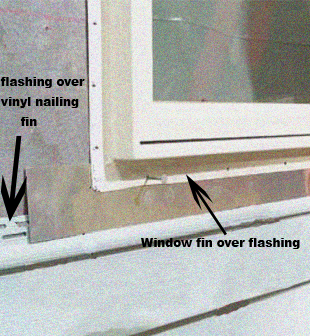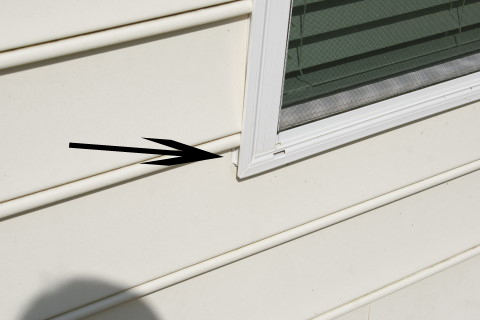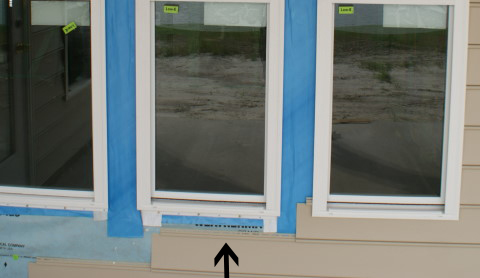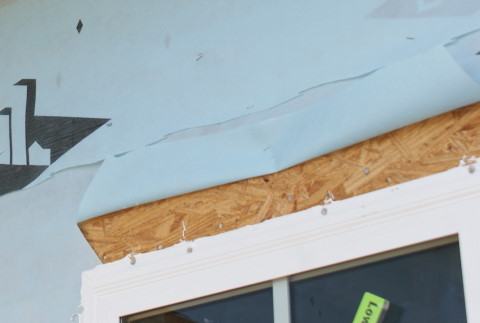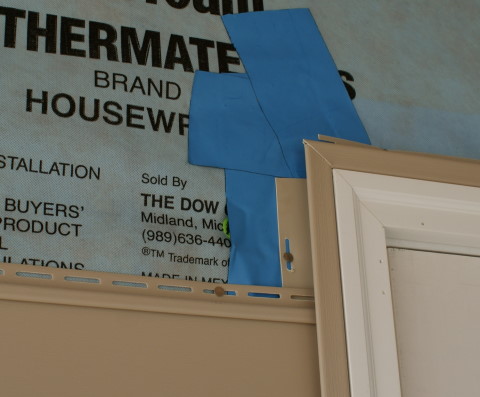This article is about houses with windows which have built in j-channel. This style of window is popular among builders because it negates the need for purchasing j channel as these window have the J channel built in. However, in the opinion of this inspector this type of window has a design flaw that necessitates installing flashing in a way which is rarely done. Moisture could penetrate the siding at the corners of the windows and enter the structure if not done properly. What happens is the rain water will flow down the siding onto the top of the window, flow down the sides of the window and enter behind the siding at the bottom corner. Flashing should be behind the bottom flange and overlap the next lower piece of siding for it to be effective as seen in the following photo.
The picture above shows how the siding guys slid a piece of flashing up under the bottom flange and then the bottom of the window was nailed off. Any water flowing down the side of the window will flow on top of the flashing and out. So the house will be protected.
So why isn’t this done more often. The simple answer is that the framers set the windows and the siding guys install the siding. If the builders would communicate with the tradesmen to let the vinyl guys finish nailing the bottom of the windows after they slide the flashing in behind the bottom window flange the problem would be solved. What we see out in the field however is an incredible amount of effort is used to tape up the windows everywhere else which is all well an good if they don’t forget to do the bottom correctly.
Though modern builders do use house wrap it’s important to remember that house wrap is not waterproof like metal flashing. House wrap is actually designed to allow a certain amount of water vapor to pass through so that wall cavities can dry out. However it does a fair job of keeping the water off the framing. Older homes may not have house wrap; so this can be more of an issue in these older homes with windows in certain locations.
Windows which are exposed to direct rain such as first floor gable end walls are more susceptible to moisture intrusion than windows located under roof overhangs. Because this style of window (and vinyl mounting boxes) are not often properly flashed; we suggest investigative measures to be certain. Windows which do not have an integral J channel but are wrapped with regular j channel are also vulnerable to this however to a much lesser degree. Since the amount of leakage is usually small it may take years before anyone notices. I’ve actually had to repair homes that were improperly flashed. Below are some pictures of homes under construction which show the typical way these windows are installed now days.
The picture above shows house wrap and seal tape well applied but the under flange flashing is not there. This is how it’s being done around here. If these windows were located on a gable end wall or on a first floor of a two story, where it could receive direct rain splashing onto the walls then the possibility of moisture intrusion is increased without the under flange flashing.
The idea behind the picture above is that when the house wrap is folded down any moisture that gets behind the siding will flow over the flange correctly.
The picture above shows how they taped up the house wrap at the top corner of the door (or window). Good work. However let’s not forget the bottom corners of the windows where the flashing is needed the most.
All these photos were taken on local area homes in the Charleston lowcountry area under the most modern building codes. If your home has vinyl windows or even windows which have regular j channel in my experience it is unlikely to have been flashed in an optimum way. Will this be a problem for you?….. maybe…. if your windows are exposed to direct rain like gable end walls or the bottom windows of two story homes. The only way to be certain is unsnap the bottom piece of vinyl and take a peek. One thing to note however is that the removal of the siding for inspection is beyond the scope of a home inspection. You’re on your own there. However; getting a home inspection is one way to protect your investment by alerting your builder to the proper procedures should he spot the deficiency.

